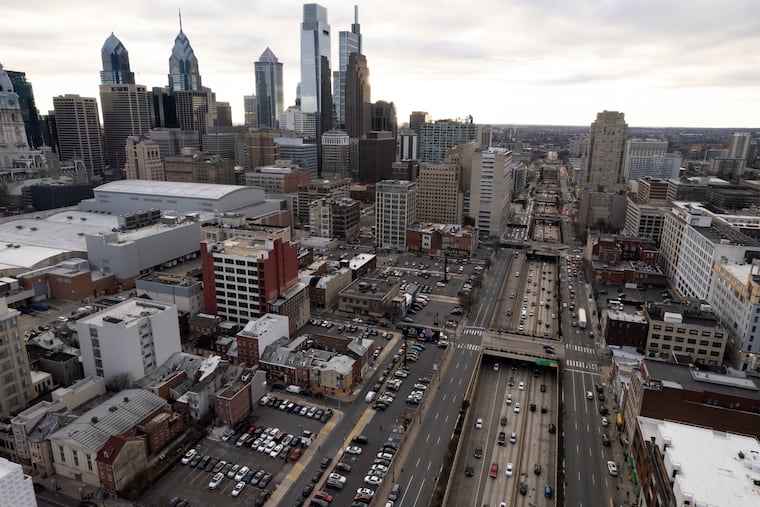The Vine Street Expressway cuts through Chinatown. New proposals recommend ways to reconnect the neighborhood.
The proposals include different capped areas of the expressway, public green areas, and an option to one day connect to the Rail Park.

The city, in partnership with the Philadelphia Chinatown Development Corp. (PCDC), has unveiled three design proposals for the Chinatown Stitch Project, which aims to reconnect the Chinatown neighborhood bisected by the construction of the Vine Street Expressway.
On Tuesday, the proposals were shared publicly to gather feedback. Each design offers a different way to reconnect the commercial center of Chinatown to the northern part of the neighborhood, where many residents live. The two areas were separated by the construction of the Vine Street Expressway, which concluded in 1991.
“There’s been about 20 plus years of talk about trying to address some of the ongoing harm that the Vine Street Expressway causes to the surrounding community,” Christopher Puchalsky, director of policy and strategic initiatives for the city’s Office of Transportation, said Tuesday at an online meeting.
Until now, there have been a lot of good ideas about how to go about the project, but no study that produced a ”cohesive concept” that could be engineered into a feasible alternative, he said.
“Some of the goals not only are to reconnect Chinatown but also to ensure that the residents who live here, the workers who work here, and the small businesses that operate businesses here, all can benefit from the Vine Street Expressway,” said John Chin , executive director of PCDC.
Residents can share their feedback about the proposals in a new survey available in English and simplified Chinese online through Oct. 6. They can also share thoughts at a public meeting scheduled for Monday, Sept. 18, from 6 to 8 p.m. at the Chinese Christian Church and Center at 1101 Vine St. There will be pop-up meetings around Chinatown also scheduled for Sept. 10 and 30.
The design priorities
The three proposals take into account community feedback gathered during the spring through pop-up events in Chinatown, a survey, and outreach using postcards. The survey, which began collecting data in March, gathered 2,335 responses, with 23% of respondents identifying themselves as residents of Chinatown.
According to those who replied to the survey, priorities for the project include:
Creating a park that can accommodate public plazas and landscapes.
Increasing the safety of the local Vine Street lanes.
Developing space for public civic buildings that serve community needs.
Taking the needs of seniors, young people, and people with disabilities into consideration.
The proposals
Each of the three designs proposes distinct areas of the expressway be “capped off,” meaning that there would be structures built over the road. All three proposals also create potential for the capped construction areas to connect to the development of the Rail Park.
The first design, coined the “Two-Block Concept,” adds two full caps to the expressway, one connecting 10th and 11th Streets, and one between 12th and 13th Streets. A partial cap between 11th and 12th Streets has an open space for ventilation that is required for the expressway.
The second proposal, named the “Three-Block Concept,” adds one continuous cap from 10th to 13th Streets. Planners warn that this design is more expensive and difficult to build than the first since it would make the expressway into a tunnel, according to the Department of Transportation’s definition, and thus require additional investments in supportive infrastructure.
The third proposal, the “Three-Block Shifted Street Concept,” is the most expensive and difficult to build, according to the city Office of Transportation. It involves bringing together the eastbound and westbound travel lanes on the south end of Vine Street. This solution would free up space north of Vine Street for green space, and allow for shorter crossing distances on 11th and 12th Streets over Vine street. Planners warn that this proposal would also be considered a tunnel, per PennDot standards, and requires moving lanes of traffic together.
Timeline and cost
At the meeting on Tuesday, Puchalsky said the hope is to finish the design of the project in three to four years and begin construction around 2028.
“This is an ambitious timeline,” he said. “A lot of things need to go right.”
Additional funding also needs to be secured. While Puchalsky couldn’t share how much each proposal would cost, he said the cap of I-95, which broke ground Wednesday, will cost around $400 million. The cap by the Free Library, which opened in 2017 and is much smaller, would have cost around $20 million in today’s dollars. Earlier this year, city officials noted that capping one block on the Vine Street Expressway could cost between $25 million and $30 million.